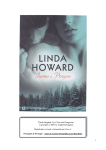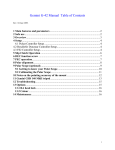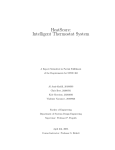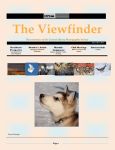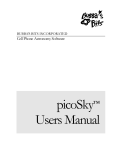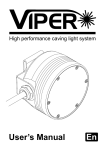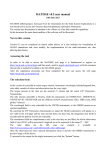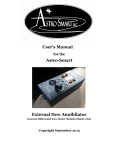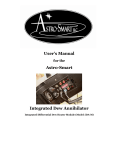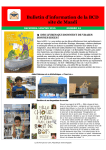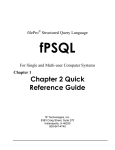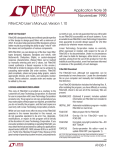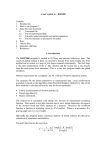Download November - Tiverton Astronomy Society
Transcript
LOGO HERE Newsletter Name The Newsletter of the Tiverton and Mid Devon Astronomical Society Volume 1 Issue 2 November 2014 In this Issue : Welcome 1 Editors Comment 2 Chairmans 3 Column Members Section 4 Dates for your Diary 14 Welcome to the second edition of the Tiverton and Mid Devon Astronomical Society Newsletter. I hope you enjoyed the first edition. Its been hard to get out and do any Astronomy of late due to almost continual cloud cover. The moment it gets dark enough, in they seem to roll. At least now its getting dark quite early, giving us all a bit of a chance to see some stars without staying up all night. The Winter Constellations should be starting to come into view in the East and the Planet Jupiter is already rising about midnight so it should be a great time to get out and catch up on some observing. Don’t forget to send any images or observations you make to the Newsletter for others to see what you are doing. Volume 1 Issue 2 November 2014 Editors Comment: I have been a little disappointed in the response to the Newsletter naming and also the Logo competitions, with not one entry to either. May I remind you that there is a small prize for the winner of each competition which at this moment is looking easy to win!! To avoid the Newsletter becoming just an insight into what myself and Pete get up too, can I request members to send in any small articles, or observations; maybe any images you’ve managed to capture for inclusion into the Newsletter. All will be appreciated and I’m sure other Members would also like to hear what you are up to and maybe try for themselves. Maybe you could write a small piece on somewhere you may have visited that would be interesting for other members to go to, so don’t be shy, send it in. In this issue we have added the article that John Parratt sends into his local newspaper on what can be seen in the night sky and a piece on NGC7000 the North America Nebula which includes an excellent image taken by Pete with his new CCD camera. Pete has also contributed a piece with his initial thoughts and observations of this new Camera. Images Provided by John Parratt Page 2 Volume 1 Issue 2 November 2014 THOUGHTS FROM THE CHAIR Hi Everyone Since our last Newsletter Astronomy has been in the news for some great and not so great reasons. On 28th October the private unmanned Antares rocket burst into flames shortly after lift-off from a Nasa Launchpad in Virginia. It was carrying a Cygnus spacecraft packed with 2,293 kg of supplies, science experiments and equipment for the ISS. Three days later, on 31st October, the Virgin Galactic Spaceship 2 exploded 45,000ft above the Mojave Desert in California sadly killing Co-pilot Michael Alsbury and seriously injuring the Pilot Peter Siebold. Both accidents are a stark reminder of the incredible dangers of spaceflight. Ground breaking news came though on 12th November when Rosetta’s lander Philae landed, somewhat precariously, on Comet 67P/Churyumov-Gerasimenk after travelling for 10 years. The Rosetta spacecraft is named after the ancient Rosetta Stone that you can visit today in London’s British Museum. The Philae lander is named after the Philae Obelisk which, together with the Rosetta Stone, provided the key to our first understanding of Egyptian hieroglyphs, or “picture words.” Scientists hope that the Rosetta spacecraft will enable us to translate the even older language of comets, as expressed by their thermal signatures, into new knowledge about the origins of our solar system and, perhaps, life on Earth. I am sure we will all be closely following Rosetta’s progress and, at the time of writing, hope that the project can achieve some of its aims. I hope many of you have been able to enjoy some of the clear nights we have had of late and especially the Moon which has been particularly beautiful. Please remember you are all welcome to join our viewing team at the Blundell’s telescope or at a dark site. If you need help or technical advice with using your own telescope please talk with the members on hand. Finally, I look forward to seeing you at our annual Christmas Party at 7.30pm on Friday 5th of December. Jo Richardson and I have organised some Astronomical fun you and know it will be a good night. Please remember to bring a few nibbles and a drink to share. Wishing you clear skies. Angela Page 3 Volume 1 Issue 2 November 2014 Members Section: John’s Corner: The Night Sky For November There were a few good nights of observing, although it was mostly the normal British weather, but I have been up early to see Jupiter rising and the views through a telescope are amazing. The cloud belts are clearly visible and if you look at the planet long enough, you can see the clouds changing and moving; this is because Jupiter has a rotation period of just 10 hours. Jupiter 2014 Apr 8 – 20:42 UT 8” LX200-ASI120MM-RRGB Taken by: Keston Brill Moon phases: Full Moon 6th November; Last Half 14th November; New Moon 22nd November; and First Half 29th November. The Planets Mercury is very low in the morning sky; it will be a half phase at the beginning of the month. Venus is very low in the evening sky; it is very close to the Sun and not so good for observing. Mars is also very low in the south western sky, but can be seen as the sky darkens. Jupiter is visible in the morning sky, in the constellation of Leo; it is very bright and easily seen. Saturn is in the same part of the sky as the Sun, so cannot be seen early in November, but hopefully will be able to be seen in the morning sky around the end of the month. Uranus is in the southern night sky, in the constellation of Pisces; telescopically Uranus is a small greenish disc. Page 4 Volume 1 Issue 2 November 2014 Subject of the month - ‘The North American Nebula’ The North American Nebula lies near the star called ‘Deneb’, which is in the constellation of Cygnus. The nebula is referred to as an ‘Emission Nebula’ and this is where gas clouds are being ionised by high energy photons from a nearby star; in other words the star illuminates the gas cloud. The Nebula lies at a distance of 1800 light years. When viewing the nebula, a lot of astronomers use several types of filters, as they highlight the gas clouds and their colours. Importantly, we are unable to see the nebula with the naked eye, as it is not bright enough, but when viewed through a telescope or binoculars under dark skies, it can be seen as a foggy patch. The best way to see the nebula is to photograph it with a digital or CCD camera, using 60second to 5-minute exposures. NGC7000 2014 July 21 & 22 William Optics ZS80QSI683WSG Taken by: Pete Richardson. Page 5 Volume 1 Issue 2 November 2014 The South West Astronomy Fair - Saturday 9th August 2014. The show took the usual format with Trade Stands, Open Outreach/Hands on Stalls and Lectures. Lectures were given by a number of well know personalities and appeared to be well attended. Brian Clegg (Author, Science Outreach) - Before the Big Bang Prof. Paul Roche (Director of the Faulkes Telescope, Univ. of South Wales) Impacts from Space Pete Lawrence (BBC Sky at Night Presenter) - The Aurora Will Gater (Astronomer, Science Writer, Presenter) - Alien Worlds & Exoplanets All of the observatories were open during the day with a couple of them offering views of the Sun during sunny spells. A few Sunspots were clearly seen and were also observable through a number of Amateur telescopes set up within the grounds. Some of these being Hydrogen Alpha scopes giving the attendees the chance to view Prominences on the Sun limb and the surface in a different light. One of the more interesting displays was to be found in the Radio Astronomy Section of the Norman Locker Observatory, with a live radio Meteor detection display and also All-Sky video monitoring for Meteors and Meteorological satellite displays. The main marque had a lot of goodies for the unwary astronomer to purchase, including Scopes, Eyepieces and CCD Cameras along with more modest items to purchase. There were one or two exhibit type stands including our very own Pete and Jo Richardson being amicably helped by John Parratt. Page 6 Volume 1 Issue 2 November 2014 Pete and Jo’s Stand at the South West Astronomy Fair Picture: John Parratt Page 7 Volume 1 Issue 2 November 2014 Review of QSI683wsg Monochrome CCD Camera by Pete Richardson. When I started out in astro-imaging I was using a one shot colour (OSC) CCD camera, both for planetary and deep sky work. I often thought about going over to a monochrome CCD but was reluctant due to the additional time (ie capturing and processing individual R G B exposures as opposed to single colour exposures) and the increased cost involved. So for several years I used the OSC colour cameras and have to say I did manage to get some pleasing results along the way. There comes a time though where after much effort spent in trying to continually improve my images it seemed as though there was very little more that I could do apart from investing in better equipment. I knew the scopes I was using were good optically & I had already invested in a new camera for planetary imaging with the purchase of an ASI120mm CMOS camera. Therefore it was now time to consider an upgrade for Deep Sky work and the best option available to me was to consider upgrading to a high end mono CCD. The lack of a Beyer matrix in front of the CCD sensor greatly increases sensitivity and resolution. The reason for this is that it allows every pixel on the sensor to receive the full signal in each wavelength of light as passed by the individual filters placed in front of it. A OSC Beyer matrix is a series of small RGB filters placed in a grid over the sensor whereby this limits the number of the pixels that receive the most sensitive light (generally via the Red filter). See figure 1. Figure 1 - Beyer Matrix as used in a OSC Camera. Page 8 Volume 1 Issue 2 November 2014 The QSI cameras have always appealed to me after seeing so many other fabulous images on the net taking by some well know imagers, so I finally plucked up the courage and placed an order for a new QSI683 mono CCD, complete with a built in filter wheel and off-axis guider port (off-axis guiders allow guide cameras to use light captured through the main imaging telescope using what is called a Pick-Off Prism. This directs a small amount of light to the guide camera - see figure 3. The main advantage to this is that it completely removes flexure from the imaging system which can be an issue with separate guidescopes). The camera arrived after about six weeks as the UK distributor was waiting for new cameras to arrive from the US where they are manufactured. The first impression when you get your hands on one of these is just how well put together they are. Superbly engineered and built to last. It also comes with standard adaptors and a very robust Pelican case. See figures 2 & 3. Figure 2 - Camera and Accessories. Page 9 Volume 1 Issue 2 November 2014 Figure 3 - QSI683wsg Camera Body. Initially I set about getting everything up and running indoors in order to get used to the operating procedure of the camera with my image acquisition software MaximDL Pro. The instruction manual is very well written so this all went smoothly and was relatively simple to do. Also I got myself used to removing the filter housing (see above) and installing the Baader LRGB filters that I had also ordered to come with the camera. These filters are positioned into a 5 position carousel and MaximDL is then set up to select the filter of choice automatically during a pre-established and saved imaging sequence. The integrated filter wheel is a beautiful solution with this camera. Due to the close proximity of the wheel to the CCD sensor, it allows 1.25" filters to be employed as opposed to a separate filter wheel which would necessitate the use of 2" filters due to the size of the sensor and the increased distance to it - this saves a very significant cost!! See figure 4. Page 10 Volume 1 Issue 2 November 2014 Figure 4 Integrated filter wheel. The sensor that comes with the QSI683 is an 8.3mp Kodak KAF-8300 and has a 3326 x 2504 pixel array, each pixel being 5.4 microns in size. This provides a very good field of view, especially when used with a focal reducer. This sensor also has a high quantum efficiency which basically is a measure of its sensitivity to faint light sources. It also has a very low noise output. Noise is the thorn in the side for a lot of astro-imagers and is a by-product of the heat generated by the sensor in use. This is why most CCD cameras are equipped with on-board thermo-electric cooling systems. This camera is able to cool to -40 degrees C and is completely programmable to a specific set-point. To date I have found -20 deg. C to be perfectly adequate for clean smooth exposures which have an excellent signal to noise ratio. This temperature also allows the camera to maintain plenty of temperature headroom if required and keeps the camera running at a sensible operating output. The sensor is protected from moisture and frost formation by way of a sealed argon chamber. This is typically good for around 3 years after which a recharge of the chamber is recommended. This is easy to do and doesn't require a return to QSI. Instructions are provided within the user manual. A mechanical shutter comes as standard and this is great for taking dark frames as it negates the need for capping the telescope. Dark frames are a sub exposure taken using the same length of time and temperature settings as the light exposures but with no light able to reach the sensor. The purpose of these fames is to allow any noise (as all CCD's have some even with cooling) to be effectively subtracted from the light frames which when stacked together produce a much more pleasing and noise free final result. Page 11 Volume 1 Issue 2 November 2014 An integrated guider port also comes as standard and this allows the camera to be used as a standalone guidecamera or to route guide signals from a secondary guide camera mounted onto the off axis guide port. See figure 5. Figure 5 - Camera Outputs. Another consideration that swayed me to the selection of this camera was its low weight. It is critical to any mount not to overload it in operation. Weight can soon build up when several other pieces of equipment are attached to the main optical tube, these typically would be a guidescope, finderscope and the counterweights themselves. The QSI683wsg comes in at 1300g which is a decent weight saving over an equivalent camera with a separate filter wheel and offaxis guider. In use the camera is very easy to operate and integrates seamlessly with Maxim DL using ASCOM compliant drivers. All parameters are controllable from within the acquisition software and the download speed of the individual exposures is very quick, even at the maximum quality setting this typically takes only around five or six seconds. This is important as it maximises the amount of time available to gather the data from the subject being imaged. The actual data captured is of a very high quality and if sky conditions are good and all other aspects of the set-up are working well (i.e. focus, guiding, good and well collimated optics) then it is capable of producing world class images. Many images seen in the astronomy publications are taken with QSI cameras and they are used by some of the world’s leading astrophotographers. I have been using the camera for around six months now and this camera has allowed me to take by far my best deep sky astro-images. Page 12 Volume 1 Issue 2 November 2014 Most of these can now be viewed on my website at peterichardsonastro.com but I included one below of M31 which is the latest deep sky image I have acquired. Pete Richardson. M31. The Great Andromeda Galaxy. 2014 Sept 21 William Optics AZ80mm APO. QSI683WSG Imaged by Pete Richardson Page 13 Volume 1 Issue 2 November 2014 Monthly Meetings and Forthcoming Events: • 7th November 2014 The Sky is not the Limit – Steve Bennett • 5th December 2014 The Big Bang Christmas Party - fun and games hosted by Angela and Jo. Please bring a small amount of drink and nibbles to share. • 9th January 2015 Young Stars: The First 10 Million Years - Darryl Sergison • 10th January 2015 -Wells Town Hall. Members of Tiverton are invited to join an Open Evening run by Wells and Mendip Astronomers. The aim of the event is to highlight the various clubs available in the region and to further promote and encourage an interest in astronomy within the general public. Anyone wanting further information regarding this particular event should contact Jo Richardson. • March 2015 - Stargazing Live. Exact dates to be advised. Committee Members Contact Details: Douglas Rice Angela Cousins David Brabban Nick Markell Melvyn Boot Chris Haughton John Parratt Jo Richardson President Chairman Treasurer Web/AV Membership Secretary Publicity Events 01884 252942 01884 243186 01884 253770 [email protected] 01884 855377 01884 242226 01271 372331 01934 708790 Newsletter Editors Keston Brill [email protected] Pete Richardson [email protected] Submissions for the next newsletter to be received by 31st January 2015 to either of the editors email address. All Material submitted and published within this Newsletter remains the property of the original submitter and is subject to copyright. Page 14














